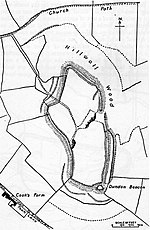Admiral Hood Monument
Cultural infrastructure completed in 1831Grade II* listed buildings in South SomersetGrade II* listed monuments and memorialsListed towers in the United KingdomMonumental columns in England ... and 2 more
Monuments and memorials in SomersetNeoclassical architecture in England

The Hood monument is a memorial column to Sir Samuel Hood on a hill near Butleigh in the parish of Compton Dundon, Somerset, England. It was completed in 1831 to a design by Henry Goodridge.
Excerpt from the Wikipedia article Admiral Hood Monument (License: CC BY-SA 3.0, Authors, Images).Admiral Hood Monument
Polden Way,
Geographical coordinates (GPS) Address Website External links Nearby Places Show on map
Geographical coordinates (GPS)
| Latitude | Longitude |
|---|---|
| N 51.101356 ° | E -2.721306 ° |
Address
Admiral Hood Monument
Polden Way
BA6 8TP , Compton Dundon
England, United Kingdom
Open on Google Maps








